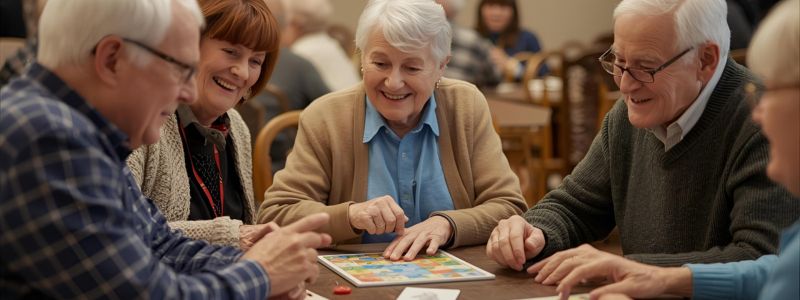
Brain training for older adults involves structured mental activities that stimulate memory, attention, processing speed, and executive function to support cognitive wellness. Recent research shows that targeted cognitive exercises promote neuroplasticity and help maintain daily functioning, mood, and independence.
This guide explains why brain training matters, which activities work best, and how to weave training into daily life and care plans. You will find evidence summaries, actionable activity lists, and caregiver strategies that align with lifelong learning and social engagement principles. The article covers top puzzles and apps, learning new skills, physical and mind-body exercises, social approaches, and answers common questions about frequency and realistic outcomes.
Importance and Benefits of Brain Training for Older Adults
Brain training activities are structured tasks that challenge memory, attention, processing speed, and executive function to strengthen neural pathways and support cognitive reserve. This mechanism relies on neuroplasticity: repeated mental challenge stimulates synaptic remodeling and improves task-specific performance, yielding better daily functioning and mood. Regular cognitive stimulation produces measurable gains in targeted skills and contributes to broader resilience when combined with physical and social health.
Mechanisms of Mental Stimulation for Cognitive Function
Mental stimulation improves cognitive function by engaging neuroplastic processes that strengthen synapses and promote compensatory networks, increasing cognitive reserve. Rehearsal and retrieval practice reinforce memory traces, and varied challenges build flexible problem-solving strategies across contexts. This mechanism supports both short-term recall and long-term maintenance of cognitive skills when activities are varied and progressively challenging.
Brain Training and Delaying Cognitive Decline
Targeted brain training can contribute to delaying cognitive decline by building cognitive reserve, though it is not a guaranteed prevention against dementia or Alzheimer’s disease. Recent reviews indicate modest to moderate effects on trained tasks and some transfer to daily function, particularly when combined with exercise, social engagement, and vascular risk management. Setting realistic expectations and combining modalities increases the likelihood of long-term benefit and quality-of-life improvements.
Best Cognitive Games and Puzzles for Older Adults

Cognitive games and puzzles provide structured, repeatable challenges that target specific mental functions like verbal retrieval, working memory, and problem solving. Choosing activities that match ability, offer graded difficulty, and encourage social play maximizes engagement and benefit.
Top cognitive activities for older adults include:
- Crossword puzzles: Enhance verbal memory and vocabulary retrieval.
- Sudoku and number puzzles: Strengthen working memory, logic, and sustained attention.
- Card and board games: Combine strategy, memory, and social interaction.
- Mobile brain training apps: Offer adaptable drills for processing speed, memory, and attention.
This comparison table maps common activities to cognitive targets and practical considerations for seniors and caregivers.
| Activity | Cognitive Target | Practical Notes (difficulty, social aspect, materials) |
|---|---|---|
| Crossword puzzles | Verbal memory, semantic retrieval | Large-print or themed crosswords ease access; untimed formats reduce pressure |
| Sudoku | Working memory, logic | Progressive difficulty recommended; paper and app options available |
| Card games (bridge, rummy) | Executive function, memory, social cognition | Group formats boost social engagement; simplified rules for varying abilities |
| Brain training apps | Processing speed, attention, memory | Choose apps with clear usability and adjustable difficulty for older learners |
Crossword Puzzles for Verbal Memory
Crossword puzzles improve verbal memory by repeatedly activating word retrieval, semantic associations, and vocabulary networks. Solving clues requires accessing long-term lexical stores and practicing retrieval. Large-print editions, themed puzzles, and collaborative solving adapt crosswords for varying abilities.
Sudoku for Brain Health
Sudoku targets working memory, concentration, and logical planning through pattern recognition and rule-based restrictions. Progressive practice from easy to moderate puzzles preserves motivation. Regular short sessions—such as daily 10–20 minute problems—help integrate puzzle practice into routines.
Card Games for Social Interaction and Cognitive Skills
Card games like bridge, rummy, and cooperative card variants combine memory, strategy, and real-time decision-making while fostering social bonds. Group play enhances verbal exchange and perspective-taking. Caregivers can adapt rules or host small clubs to maximize engagement.
Social Engagement and Cognitive Training with Card Games for Seniors
Let’s Play Cards: Multi-Component Cognitive Training With Social Engagement Enhances Executive Control in Older Adults
Let’s play cards: Multi-component cognitive training with social engagement enhances executive control in older adults, YM Huang, 2018
Top Brain Training Apps
Brain training apps offer modular exercises targeting processing speed, attention, memory, and problem solving with adjustable difficulty and accessibility features. Prioritize clear interfaces, larger fonts, and evidence-based exercises. Apps work best as one component of a broader program that includes social and physical activity.
Lifelong Learning for Brain Vitality
Lifelong learning activities stimulate multiple cognitive systems simultaneously by combining new information, practice, and feedback processes that drive neuroplasticity. Learning a language, picking up an instrument, or engaging in creative arts activates memory, attention, executive planning, and sensory-motor systems together. This multi-domain stimulation builds transferable skills and cognitive reserve.
Learning a New Language
Learning a new language enhances executive control, working memory, and attention by requiring bilingual switching, new vocabulary encoding, and auditory discrimination. Regular practice with conversation, flashcards, and structured lessons encourages neural adaptation. Short daily sessions and conversational practice yield measurable improvements.
Playing a Musical Instrument
Playing music engages auditory processing, motor coordination, memory encoding, and pattern prediction, producing broad neuroplastic effects. Even beginner lessons provide multi-sensory learning and require sustained attention. Structured practice plans promote steady improvements in memory and motor planning.
Creative Writing and Artistic Pursuits
Creative writing and art activate narrative memory, planning, and expressive language while reducing stress. Short creative prompts, journaling, and group art sessions build planning skills and semantic retrieval. These pursuits support executive function and provide purpose and social connection.
Physical Activities for Brain Health
Physical activities support brain health by increasing cerebral blood flow, neurotrophic factors, and mood-regulating neurotransmitters that enhance cognition and resilience. Aerobic and mind-body practices each contribute distinct mechanisms. Selecting safe, regular routines adapted for mobility yields cognitive and emotional benefits.
Aerobic Exercise and Cognitive Function
Aerobic exercise raises heart rate and cerebral perfusion, delivering oxygen and nutrients that support synaptic function and neurogenesis; it also increases brain-derived neurotrophic factor. Practical sessions such as brisk walking or cycling for 20–40 minutes three times weekly balance efficacy with safety. Start with manageable durations and build gradually.
Mind-Body Practices: Yoga and Tai Chi
Yoga and Tai Chi reduce stress, improve attentional control, and enhance coordination, supporting cognitive function and fall prevention. These practices combine slow, focused movement with breath regulation, improving executive attention and emotional regulation. Low-impact adaptations make them accessible for varying mobility levels.
Social Engagement for Mental Well-being and Cognitive Health

Social engagement provides cognitive stimulation through conversation, collaborative problem solving, and shared activities that reinforce memory and language skills. Purposeful social roles and structured group activities increase routine, motivation, and opportunity for multi-domain challenge. When integrated into clubs, volunteer roles, or learning cohorts, social engagement amplifies the benefits of cognitive exercises.
Group Activities and Senior Clubs
Group activities stimulate language, problem solving, and perspective-taking through discussion, cooperative tasks, and shared learning objectives. Clubs that incorporate puzzles, book discussions, or hobby workshops provide regular cognitive challenge combined with social reinforcement. Adapting activities for mixed abilities keeps participation inclusive.
Volunteering for Brain Function and Emotional Health
Volunteering provides structured roles that combine routine, purposeful tasks, and social interaction, all supporting cognitive activity and emotional well-being. Roles like mentoring or community coordination offer varying cognitive loads. Purpose-driven activities encourage sustained commitment and provide natural contexts for practicing organizational and communication skills.
Integrating Brain Training into Care Plans
Integrating brain training into care plans means mapping activities to daily routines, care settings, and caregiver support to ensure consistent cognitive stimulation. Practical steps include assessing baseline abilities, selecting appropriate activities, scheduling daily short sessions, tracking progress, and adapting tasks for safety and engagement. Care plans should balance individual preference, social opportunities, and progressive challenge to build sustainable habits.
Steps to integrate brain training into care plans:
- Assess: Document current abilities, interests, and mobility to match activities.
- Plan: Choose 2–4 varied activities that target different cognitive functions.
- Schedule: Build short daily sessions and weekly group activities into routines.
- Support: Train caregivers to adapt tasks, monitor progress, and encourage participation.
This checklist helps families and providers create consistent, measurable cognitive routines that align with daily care.
| Care Setting | Example Cognitive Activities | How Caregivers Can Support |
|---|---|---|
| In-home care | Short puzzle sessions, language practice, music listening | Provide materials, prompt gently, schedule consistent times |
| Assisted living | Group trivia, card games, art classes | Facilitate group sign-ups, adapt rules, monitor engagement |
| Day programs | Structured learning sessions, exercise classes with cognitive tasks | Coordinate activities, track attendance, provide feedback |
Age Well Now's Role in Brain Health Support
Age Well Now provides informational resources, Lifelong Learning content, Interactive Courses, and Aging Well Guides to help families plan cognitive-supportive care and structured learning for older adults. The platform connects readers to guidance on matching activities to needs and highlights care options that incorporate cognitive stimulation.
Caregivers' Role in Facilitating Cognitive Activities
Caregivers motivate, adapt, and scaffold cognitive activities by providing materials, simplifying instructions, and creating predictable schedules. Simple caregiver scripts encourage participation and reduce frustration. Tracking brief progress notes and adjusting difficulty maintains appropriate challenge. Caregiver involvement is essential for safety, accessibility, and consistent practice.
Recent Research on Brain Training Effectiveness
Current research (2024–2025) indicates that targeted brain training yields reliable improvements in trained tasks and modest transfer to related cognitive functions, especially when combined with exercise and social engagement. Meta-analyses show larger effects for multi-domain interventions and for participants who maintain regular, long-term practice. The consensus supports combined, sustained approaches over short, isolated programs.
| Study | Sample / Duration | Key Finding |
|---|---|---|
| 2024 randomized trial (multi-domain) | Older adults, 12 weeks | Multi-modal training improved memory and daily function modestly |
| 2024 meta-analysis | Multiple trials, varied durations | Larger effects for multi-component programs vs single-task training |
| 2025 review | Longitudinal cohorts | Consistent engagement linked to slower cognitive decline estimates |
Key Findings from 2024-2025 Studies
Recent trials show that combined interventions—cognitive training plus exercise or social engagement—produce more consistent and broader effects than isolated brain games. Studies report modest transfer to everyday tasks and suggest that frequency, duration, and variety predict improved outcomes. Longitudinal analyses highlight the importance of sustained engagement to influence cognitive trajectories.
Mentally Stimulating Activities and Alzheimer’s Onset
Mentally stimulating activities build cognitive reserve by strengthening alternative neural networks and enhancing synaptic efficiency, which can delay clinical expression of Alzheimer’s symptoms even when pathology is present. Evidence links higher lifelong cognitive engagement with later onset of clinical impairment. The most effective prevention strategy combines cognitive challenge with vascular risk reduction, exercise, social engagement, and healthy lifestyle habits.
Frequently Asked Questions (FAQs)
What are the best brain exercises for seniors to keep minds sharp?
The best exercises are varied and consistent, combining word games, number puzzles, strategy games, learning new skills, and physical activities with cognitive elements. Short daily sessions plus weekly group activities maximize adherence and cross-domain transfer.
Do brain training games really improve memory and thinking skills?
Brain training games reliably improve trained tasks and can improve related cognitive skills with regular, varied practice. Meta-analytic evidence supports modest transfer, especially for multi-domain interventions and sustained use. For broader gains, combine games with physical exercise, social activity, and lifelong learning.
How often should older adults practice brain training activities?
Short daily practice (10–30 minutes) with weekly variety and periodic group sessions balances efficacy with feasibility. Consistent, repeated challenge is more important than single long sessions. Track progress and adjust difficulty to maintain engagement.
Can brain training help prevent cognitive decline naturally?
Brain training contributes to risk reduction by building cognitive reserve, but prevention works best as a combined lifestyle approach including exercise, social engagement, healthy diet, and vascular health management. Cognitive activities are one key pillar alongside others that influence brain aging.
Conclusion
Engaging in regular brain training activities is a vital component of maintaining cognitive health and overall well-being for older adults. By incorporating a diverse range of cognitive games, lifelong learning, physical exercise, and social engagement, seniors can stimulate neuroplasticity, build cognitive reserve, and enhance daily functioning. While not a guaranteed prevention for dementia, a comprehensive approach significantly contributes to delaying cognitive decline and improving quality of life. Consistency, variety, and personalized adaptation are key to successful and sustainable brain health routines, supported by caregivers and resources like Age Well Now.

